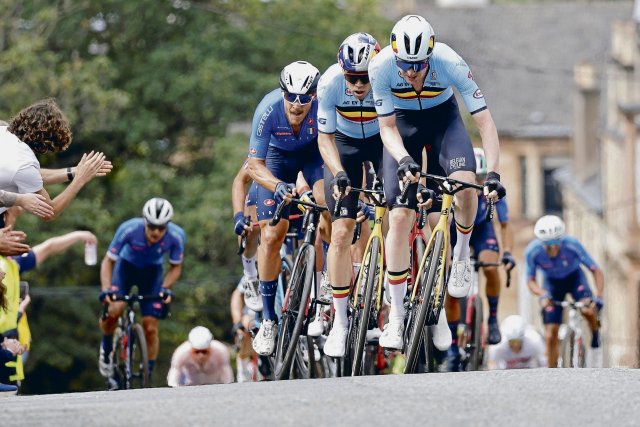From one hundred to zero: Belgian top driver Nathan Van Hooydonck (front) suddenly felt his heart stop.
Photo: image/Jan De Meuleneir
It wasn’t long ago that a cluster of deaths in cycling caused great excitement. That was in the years 2016 to 2020. Most recently, the old worries came back: this year due to the traffic accident of the Belgian professional Nathan van Hooydonck due to a sudden cardiac arrest or the collapse of the Italian European champion Sonny Colbrelli during the Tour of Catalonia in 2022.
The unusual, almost unbelievable thing about it was that riders kept falling off their bikes – without any obstacle being the reason. Then they lay on the asphalt or in the embankment. And although racing doctors and paramedics tried every resuscitation method possible, some young men in those years between 2016 and 2020 did not wake up again. The then 23-year-old Michael Goolaerts died in 2018 on his debut in the cobblestone classic of Paris-Roubaix: He had covered around 100 kilometers, suddenly fell, remained lying down – and the doctors could only diagnose death due to cardiac arrest.
Goolaert’s Belgian compatriot Daan Myngheer didn’t even live to see his 23rd birthday. Two weeks earlier he died at the Criterium International in Corsica in 2016: he apparently felt problems and dropped back from the peloton. When he tried to stop, he simply tipped over. His cause of death was given as a heart attack. Both professionals drove for the then Belgian junior racing team Verandas Willems. Top stars like Wout van Aert and Tim Merlier learned the basics of cycling there and rode in this team in the same season as Goolaerts.
In previous years, the racing team also attracted attention for doping. The Belgian professional Leif Hoste was convicted around 2012 with suspicious blood passport values and was subsequently banned. The year before, teammate Stefan van Dijk made headlines with the banned ozone therapy of his blood that was removed and returned. However, it was never determined to what extent doping could have been a contributing factor in the later deaths and whether Myngheer and Goolaerts had doped at all. However, there may be a connection between doping and cardiac arrest. “Doping is definitely a very important factor that can lead to sudden cardiac death,” explains sports doctor Dierk-Christian Vogt to “nd”. Vogt is a cardiologist who also looks after competitive athletes in handball, ice hockey and water polo. He also counts the doping classics Epo and steroids among the substances that can cause heart problems.
However, the suspicion of doping is not suitable as a monocausal explanation. Sudden cardiac death also affects the normal population. And in general, Tour de France participants live longer than their peers who have not completed a Tour of France. At least that’s what an evaluation showed ten years ago for all French Tour participants from 1947 to 2012.
Cardiologist Vogt was also unable to determine a particular increase in deaths from heart disease in cycling. »However, there are no systematic studies on this. “In no country in the world do we have a register in which heart disease or deaths in athletes have to be reported,” he adds. There are some voluntary registers, but they mainly concern recreational athletes. The statistical situation is therefore rather poor.
If athletes die of sudden cardiac death, excessive stress is not the cause. At worst, it is the trigger. “Only a previously diseased heart can be put in life-threatening situations through exercise,” emphasizes Vogt. He only sees exceptions for athletes who have been practicing sports at the upper limit for decades, such as the professionals in long-distance triathlons. »Anyone who does this for 20 to 30 years can develop slightly more cardiac arrhythmias than the normal population. This has now been relatively well researched. But it’s not life-threatening,” he explains. And according to Vogt, the oversized endurance hearts that cyclists develop during their careers are not a reason for heart attacks: “This is an expression of a particularly efficient heart and not a sick heart.”
However, things become critical when people with previous illnesses engage in competitive sports. Then even just 13 kilometers can lead to death, as was the case with Niels De Vriendt. The then 20-year-old cyclist died in the early stages of a junior race, which was the very first to be held in Belgium in 2020 after the pandemic conditions were relaxed. Preliminary examinations are therefore the be-all and end-all.
Heart specialist Vogt doesn’t just value technology. »The most important thing, as always in medicine, is a precise conversation. Because almost nothing ever happens without symptoms appearing beforehand. So he asks whether someone has ever felt dizzy while exercising, whether they have had a racing heart or loss of consciousness. Cardiovascular diseases in the family environment must also be clarified. »Most of the things that can lead to death, especially in young competitive athletes, are congenital disorders that must have probably already occurred in the family in some form. Nobody talks about it so spontaneously, it’s also a source of shame.”
Physical examinations are just as important; Vogt recommends these regularly for competitive athletes from the age of 12. For professional cyclists, health checks have long been linked to the issuance and renewal of professional licenses. The heart rate is measured daily; hardly any professional trains without this equipment anymore. Nevertheless, even in today’s data-obsessed cycling world, not everything is recognized. Van Hooydonck, for example, had his last check in December 2022. According to him, everything was okay. Nevertheless, while driving in September 2023, his heart suddenly stopped. He was resuscitated by rescue workers, and a cardiac arrhythmia was diagnosed in the hospital and a pacemaker was inserted.
Van Hooydonck is still puzzling today as to what happened to his body. »I keep asking myself: Have I perhaps trained too hard? But no one can tell me how the anomalies could have developed within nine months of the last check,” he said in the fall. He also cites the more intense races as possible reasons. “We used to drive really hard for the last two hours of the race, but now it starts three hours before the finish,” he said.
A good development can be said that the racing drivers no longer died in the end, but were able to be saved, as was the case with Van Hooydonck or Colbrelli. You now have pacemakers. Your career is over. But they are alive.
nd.Christmas promotion

This will be a celebration: give away nd.Digital
Give away the Superfair digital campaign subscription for 59.40 euros (9.90 euros/month).
6 months of reading »nd« digitally in the nd.App and as nd.Epaper. The subscription ends automatically.
dasnd.de/weihnachtsaktion
judi bola sbobet88 judi bola judi bola online
